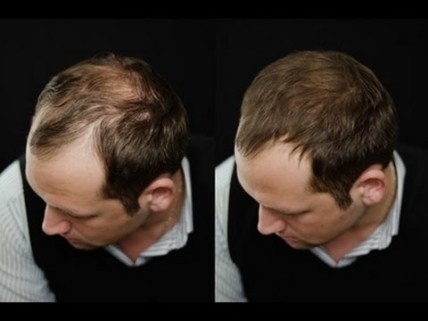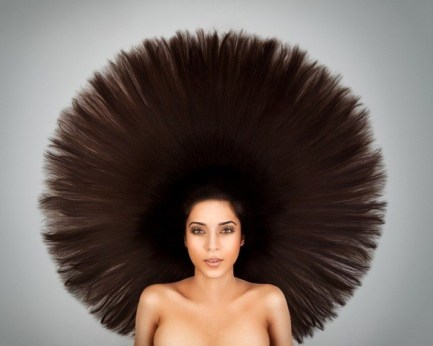Hair grows everywhere on the human skin except on the palms of our hands and the soles of our feet, but many hairs are so fine they’re virtually invisible. Hair is made up of a protein called keratin that is produced in hair follicles in the outer layer of skin. As follicles produce new hair cells, old cells are being pushed out through the surface of the skin at the rate of about six inches a year. The hair you can see is actually a string of dead keratin cells. The average adult head has about 100,000 to 150,000 hairs and loses up to 100 of them a day; finding a few stray hairs on your hairbrush is not necessarily cause for alarm.
At any one time, about 90% of the hair on a person’s scalp is growing. Each follicle has its own life cycle that can be influenced by age, disease, and a wide variety of other factors. This life cycle is divided into three phases:
· Telogen — resting phase that lasts about two to three months; at the end of the resting phase the hair is shed and a new hair replaces it and the growing cycle starts again.
As people age, their rate of hair growth slows.
Much like the rest of your body, your hair goes through changes as you get older. The hair cycle — rest, shed and grow — slow downs, and can lead to hair loss, which can be very traumatizing.
“Your hair changes every seven years,” explains women’s hair restoration expert Lucinda Ellery. “There are 150,000-200,000 hairs on our heads; we actually shed 100 a day, 36,000 in a year on average. It regenerates at approximately the same rate, although a little bit less each trimester.
“By the time you’re 15, it’s the best head of hair you’ll have for your entire life.(Editor’s note: Wah!) By the time you’re 30 there will be a significant change in your hair, but not one you may have clicked into mentally. By the time you’re 37, 40, there’s a marked changed. This is where people panic — it’s a natural cycle of aging.”
“The causes are always the same,” says Dr. Mickey Barber, president of Cenegics Carolinas, an age management institute. “The number one reason is stress, number two is iron deficiency and the number three is hormonal, which could be affected by menopause, perimenopause.”

Instead of panicking at the strands of hair in your brush, Ellery recommends taking control of your body by eating healthier.
“It’s really how healthy your body is. You start to notice more shine and elasticity, if you start treating your body from within.,” Ellery told the Huffington Post. “if you have a way of finding out if your body is acidic, imbibe foods that would make it more alkaline: Fresh vegetables, fresh salads, fresh nutrients in our drinks and our foods. [Avoid] acid making foods like milk and dairy products, breads, and potatoes [because they] change the pH value of your body.”

Everyone loses hair. It happens during your morning shower, while you’re blowing it dry, or when you give it a quick brush—and that’s normal. “On average, we lose fifty to a hundred hairs a day,” says Francesca Fusco, MD, a New York City dermatologist who specializes in hair loss. “That’s just hair going through its cycles, and there will be a new one to replace it.” But hair loss may be a sign of a more serious medical condition that needs an evaluation by a dermatologist and possible treatment. Here are nine causes of hair loss and how to deal with them.
Telogen Effluvium
Telogen effluvium is a phenomenon that occurs after pregnancy, major surgery, drastic weight loss, or extreme stress, in which you shed large amounts of hair every day, usually when shampooing, styling, or brushing. It can also be a side effect of certain medications, such as antidepressants, beta-blockers, and nonsteroidal anti-inflammatory drugs. During telogen effluvium, hair shifts faster than normal from its growing phase into the “resting” phase before moving quickly into the shedding, or telogen, phase.
The symptoms: Women with telogen effluvium typically notice hair loss 6 weeks to 3 months after a stressful event. At its peak, you may lose handfuls of hair.
The tests: There are no tests for telogen effluvium, but your doctor may ask you about recent life events and look for small “club- shaped” bulbs on the fallen hair’s roots. The bulbs mean the hair has gone through a complete cycle of growth, suggesting that the cycle may have sped up due to stress.
What you can do: In some cases, such as pregnancy or major surgery, you may have to bide your time until the hair loss slows. If medication is the culprit, talk to your doctor about lowering your dosage or switching drugs. If it’s stress-related, do your best to reduce anxiety.
Hereditary Hair Loss
Hair loss that is genetic is known as androgenetic alopecia and, according to the American Academy of Dermatology, is the most common cause of hair loss. The gene can be inherited from either your mother’s or father’s side of the family, though you’re more likely to have it if both of your parents had hair loss.
The symptoms: Women with this trait tend to develop thinning at the hairline behind the bangs, says Pamela Jakubowicz, MD, a dermatologist at Montefiore Medical Center in New York City. The condition develops slowly and may start as early as your 20s. You may be vulnerable if your mother also has this pattern of thinning. In some cases, the hair loss may be diffuse, meaning it’s spread across the entire scalp.
The tests: Your dermatologist will examine the pattern of hair loss to determine if it’s hereditary and may order blood work to rule out other causes, Dr. Jakubowicz says. A biopsy of your scalp is sometimes done to see if the hair follicles have been replaced with miniaturized follicles, a surefire sign of hereditary hair loss.







